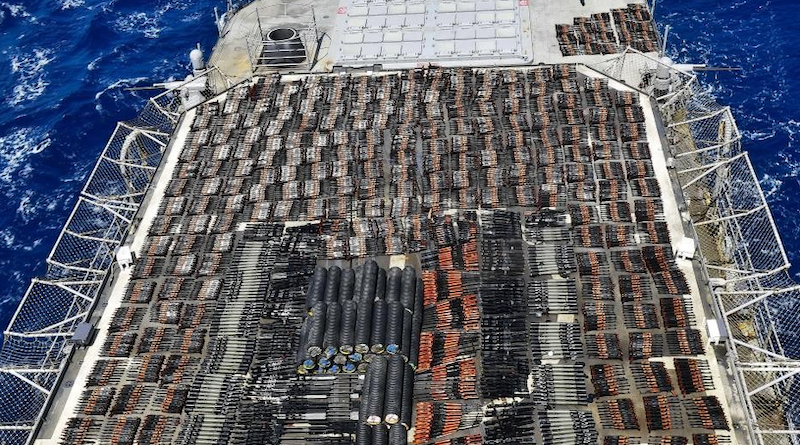Iran’s arms smuggling to Africa has been ongoing for years. A cat-and-mouse game has been taking place, with the international community tracing Iranian weapons transfers ever since the 1983 Beirut bombing that killed hundreds of Americans. Significantly for Europe and the West, Iran seems to be increasing its activities in Africa. Iranian arms sales in Africa, particularly in certain regions, are beneficial to Russia and China and run counter to Western interests.
Iran’s weapons production is increasingly sophisticated. It moves from market to market, depending on buyers and the pervasiveness of the environment. Iran’s increasing partnerships with China and Russia make Tehran increasingly seek new interests in Africa, especially regarding Moscow and its proposed base in Sudan. The Iranian merchant shipping industry is also seeking to increase its capacity to sail around the East Coast of Africa to the Gulf of Guinea. Weapons get mixed up in this trade flow.
Iranian foreign policy toward African states is undergoing a sharp increase in activity and outreach. Foreign Minister Hossein Amir-Abdollahian visited Mali and Tanzania last year and Mauritania this year, opening new lines of diplomatic and shipping/trade opportunities. Weapons get mixed into such activities, as was witnessed during the days when Iran had arms factories in Sudan under Omar Bashir.
With Yemen becoming an increasingly difficult market to sell in because of increasing interdiction by Arab Gulf partners, Tehran is funneling more weapons into the Horn of Africa, specifically Puntland. Such a move by Tehran runs counter to a multitude of interests. Last week, an agreement was signed between Somalia, Qatar, Turkey, the UAE, the UK and the US to support Somalia’s efforts in the fight against weapons smuggling.
The seaborne Iranian arms transport system uses the same route that has been run for decades by maritime shippers and traders. The arms network that runs along the southern part of the Arabian Peninsula into the Horn of Africa is tough to police. Prohibitions of Iranian weapons shipments help but delivery outside of the Bab Al-Mandab Strait makes for a wider maritime space to police.
Iran has sold weapons to many African countries. Research shows Iranian ammunition is in service with a range of entities, including government forces (Guinea, Ivory Coast, Kenya and Sudan), warring civilian communities (Kenya, South Sudan and Uganda) and rebel, insurgent and militia groups (Ivory Coast, Darfur, the Democratic Republic of the Congo, South Sudan and Niger). There is a strong history of Iranian arms falling into the “wrong hands.” Research shows that Iranian ammunition is in service with factions aligned with Al-Qaeda in the Islamic Maghreb operating in Niger.
Transfers of Iranian ammunition have contravened UN sanctions on Ivory Coast and plausibly violated UN embargoes on the Democratic Republic of the Congo and Darfur. There is no evidence to suggest the direct involvement of Iran in these violations, but the potential is there. Why play with fire?
According to a 2012 report by Conflict Armament Research, “with the exception of Khartoum-aligned forces in Darfur and South Sudan, the regional sources of this ammunition are unclear. In the Ivory Coast case, ammunition deliveries certainly transited the territory of Burkina Faso and match the types of ammunition circulating in Darfur.” It remains to be seen what happens as China and Russia boost their involvement in African affairs. Iran acts as a fifth column source when necessary.
In a meeting with his Senegalese counterpart Aissata Tall Sall, Amir-Abdollahian this week emphasized the importance of Africa in Iran’s foreign policy and the important position of Senegal in Africa. Senegal is a key country on the continent, as the African Union was until last month led by Senegalese President Macky Sall and the UN’s mission in Libya is headed by prominent Senegalese diplomat Abdoulaye Bathily. Combined with Tehran’s relations with Mali and Algeria, in addition to Mauritania, there is a growing Iranian presence in the Sahel, especially in Libya’s “underbelly.” North Africa is a key Iranian focus, particularly the areas around Libya.
The state-to-state level matters for Iran in Africa. Tehran’s close ties with Algeria are a particularly important factor. Algeria’s relationship with the Palestinians is key for Tehran, giving it an added voice, especially during today’s troubling situation in Israel and the Occupied Territories. Tehran is able to go to other countries and perhaps weaponize the issue if necessary.
Israel’s growing interactions with the Horn of Africa states, particularly Somalia and Sudan, brings up questions about the intersection with Iranian arms sales. Tehran’s arms sales can set the stage for a confrontation within these states. Does Iran want to upset the Somali political landscape with weapon sales in Somaliland as a way to garner access to the tip of the peninsula and earn greater influence?
Overall, Iran’s arms transfers to the African continent serve a number of purposes, which signal that Tehran continues its elicit revenue practice, while facing morality issues at home.

